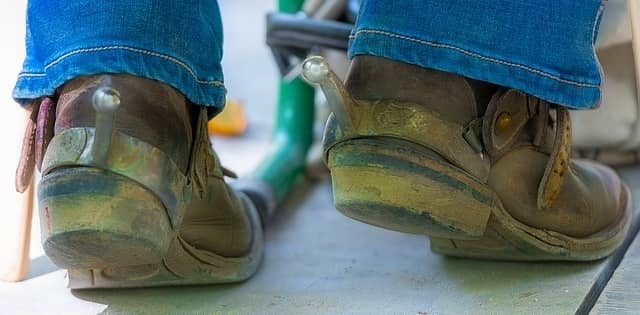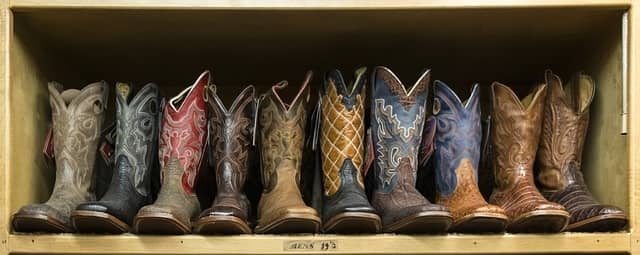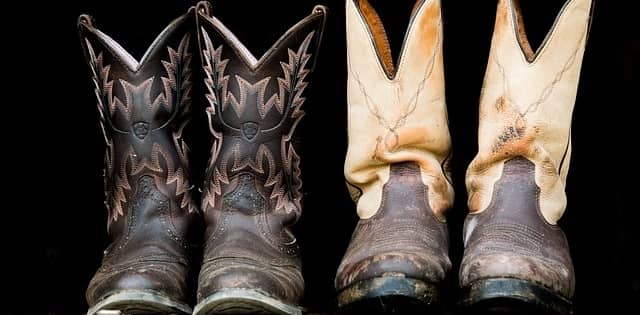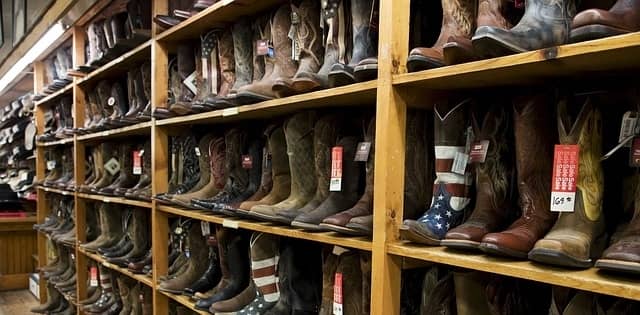Who doesn’t love the idea of a solid pair of cowboy boots, either for work or play? Its iconic design is one that lives on forever. Having said that, there’s a few things to take into consideration when living up to this iconic design, and that is waterproofing.
Before you invest in a pair for yourself, you might wonder: are cowboy boots waterproof?
While genuine leather boots do have some waterproof qualities, water may still damage the leather or shorten its lifespan. So, even though cowboy boots aren’t 100% waterproof, with a little bit of maintenance, you can preserve your boots for as long as possible.
In this article, you will find the way to maintain your boots should water find its way to their tanned canvas, some warnings of drying water-soaked boots, and finally, a few tidbits on maintenance.
How do I waterproof my boots?
By pausing before jumping into your new cowboy boots, you can take a few necessary steps to ensure your boots continue to look undamaged from potential pop up showers.
Allowing your boots to take a bath without proper protection is asking for your boots to wear out faster, potentially harbor mold and mildew, discolor, and crack. With the unpredictability of Mother Nature, and the fact you dished out hard earned money for your boots, why would you not take a few steps to ensure your new pair is not next season? After all, it is April showers bring May flowers not April rain bring boots’ pain.
If your boots are brand new, you get to skip the step of cleaning! Congrats. Keep in mind the instructions below are for leather cowboy boots and not suede.
Cleaning
Before you start using any type of conditioner or sealant, you must ensure your boots are clean. If you just brought them home from the store, clearly you are good but if not, take a moment to ensure your boots are free from debris, mud, dirt or dust.
Although cowboy boots do not have laces, if you apply this article to another pair of leather boots, make sure you take out the laces first. Remove all of the large pieces of dirt and mud stuck to your boots. This can simply be done with a dry cloth or dry brush.
Grab the leather cleaner or dish soap and water and get to work. Remember you are not trying to saturate your boots in water but get them clean. A damp cloth (squeezed out) with the cleaning solution is enough to wash your boots.
Wipe off the mixture with a clean, wrung out towel. Repeat the wash and wipe off method for exceptionally dirty areas until you feel the boots are completely clean.

Apply leather conditioner
The conditioner is used to keep the cowboy boots pliable and soft. It further helps to prevent the dust and dirt from wearing down the boots. A note of caution here: any products that are oil based will darken the leather, so keep that in mind when picking a conditioner.
To apply, massage the conditioner into the boots. You could have very dry boots that instantly soak up the conditioner. If this is the case, simply apply a bit more. Always use a dry, clean cloth when applying conditioner. You are done when the conditioner stops absorbing and a thin layer is on the boot. Let them sit for 12 hours before wiping off with a dry cloth.
If you skipped purchasing the conditioner when you bought your boots, you can read an overview of boot conditioners in the table below. This will help with making the right choice and determine the one that is right for you.
| Name | Product Image | Editors Choice | Price |
|---|---|---|---|
| Leather Honey Leather Conditioner |  | ★★★★★ | Click to see price |
| Obenauf's Heavy Duty LP Leather Conditioner Natural Oil Beeswax Formula |  | ★★★★★ | Click to see price |
| Chamberlain's Leather Milk Conditioner |  | ★★★★☆ | Click to see price |
| Sof Sole Mink Oil |  | ★★★☆☆ | Click to see price |
| Red Wing Heritage Mink Oil |  | ★★★☆☆ | Click to see price |
Spray or oil
Silicone sprays are easy and convenient but can dry out the leather. Look for low silicone or non-silicone sprays. The spray will protect for discoloration and fading due to everyday exposure to the sun’s rays.
Mink oil can be used instead of the spray. As mentioned earlier, anything with oil runs the risk of darkening the leather, so keep that in mind. Simply massage the oil in and wipe off.
These steps ensure the boots are safe from water. Although the leather is naturally waterproof, it doesn’t mean you want wear and tear from failing to add the extra protection.
Drying
Dry your boots by placing them out of the sun or any other direct heat source. Leather dries out and drying out the leather is counter-intuitive to your end game. Give your boots time to really dry – at least 48 hours. Use newspapers or boot trees to hold the shape of your boots during the drying process.

Common mistakes
Although the process seems pretty simple, mistakes can still be made when waterproofing your cowboy boots. Below are a couple common errors.
Over conditioning
This is typically caused by a person using too much conditioner at once. Imagine a lot of sunscreen on your face at one time. You can almost see your pores clogging. The same goes for the pores on your cowboy boots.
To give some relief to what may now be a sticky situation, begin by dabbing as much excess conditioner off as possible. Then use leather cleaner to clean out the boot. If you do not have leather cleaner, you could try a bit of rubbing alcohol, of course testing an area first to ensure there is not a bi-product of color damage.
Clean until the leather feels soft. Should it harden, return to the conditioner to soften it up again.
For the future, condition your boots about every six month or when you see the leather is cracking or creasing.
Drying with heat
Although it is tempting, do not dry your boots with a hairdryer, campfire, register or any other source of heat. This will change the leather, making it more susceptible to cracking. Further, the glue holding the various layers of the boot together will be compromised.
Make sure prior to drying, your boots are clean with the laces out. If you need to speed the process up, you can purchase boot dryers. You could also use a simple stand fan by propping the boots in a fashion that the fan can hit them.
Finally, you can mimic the same rice trick you use when your drop your cell phone in water. Simply fill a bin with rice, put your boots in and close the lid. The rice absorbs the moisture and your boots dry faster.
Be mindful of the material
While much of this guide is directed at leather cowboy boots, there is a plethora of other materials that could be used to create the mini art display located on your feet. That said, without being mindful of the material of your boots, you could inadvertently destroy your Picasso.
Take snakeskin boots. By getting the scales too wet, you could damage the membranes and destroy the scales. Further, when conditioning, you need to use a conditioner that is lanolin based and not oil based.
Although the details are different, the same general concept applies to suede, alligator, vinyl, and more. Thankfully a google search is always close by and the few extra minutes to research will save the heartbreak of ruined boots.

My boots already got wet…
Depending on the current condition, wet boots are not necessarily a death sentence. They require a bit more treatment based on the state they are currently in.
The biggest thing to remember is if your boots are genuine leather, leather does not want to dry out. That will cause cracking, warping and in general, an undesirable state.
Drying cowboy boots
Your gut reaction is to yank those suckers off and turn them upside down over the radiator. Don’t. Simply take the newspaper out of the recycling bin, stuff it in the boots and allow them time to air dry. Resist the urge to wear them again until they are totally dry.
If you opt to use or purchase a boot dryer, rest assured you can use the dryer for other items, as well. Wet gloves, sports shoes, shin guards, and more. Reviews will help you figure determine if the dryer has a specific function or multifunctional, including being used for leather.
Click here for an in-depth article on boot dryers
Salt stained boots
Unexpected rains can lead to soggy boots. You quickly take them home to dry only to realize you have now become the owner of a white squiggly lined boots. Do not despair; you can still fix this.
Just like your momma’s favorite home cleaning remedies, water and vinegar is the trick here. Use two parts water to one-part vinegar. Dampen a cloth with the mixture and rub the salt water stain. When it has come out, make sure to dry off and condition the boot again. Because vinegar can also shrink leather, it is not a bad idea to stuff the boot with newspaper or another substance to hold it in place.
Cracking leather
Check for mildew and mold
As a wet environment is potentially the culprit for the cracking, not to mention a foot in the boot causing humid conditions, it is not inconceivable that there may be some mildew issues.
Take your boot outside into open air. The last thing you will want to do is breathe in the nasty green squatters you brush off. Then using a dry cloth, brush off and remove as much of the mold/mildew as you can. Ideally, you dispose of this cloth, as mold spores are not house guests.
Clean the leather
If you are unsure what is on the boots, saddle soap is a solid option for cleaning. Because saddle soap contains lanolin (a substance made from the secretions of sheep’s skin glands to condition their wool), it helps to preserve the leather.
Saddle soap has lye in it, so you need to be cautious when using saddle soap to ensure it will not harm your leather. Some people have mentioned saddle soap can make the leather darker and can be disastrous for boots. The saddle soap of the past was made to use on hard leather saddles but today they have formulated saddle soap to be balanced to use on your boots.
When using the saddle soap, make sure the leather is not too wet and to add a little water if the soap starts to bubble.

Fix the cracks
You need mink oil for this step. Mink oil is obtained during the harvesting of animal hides. The fat layer is removed, and the oil is obtained through this layer and is super moisturizing. Should you not want to use mink oil for animal rights reasons, you can try Obenauf’s Leather Oil, Sno-Seal or Huberd’s Shoe Grease as a plant based alternative.
Heads up: mink can discolor the leather, so make sure to test this out in a small spot first. If you are weary about potentially discoloring the boots, you may want to skip this step. Using the back of a spoon, work the mink oil into the cracks.
While this isn’t going to suddenly return the cracks to pre-damaged status, it will moisturize them, allowing the cracks to appear less severe. Make sure you stuff something inside your boot to hold its shape while working with the leather. Would be a tragic waste to go through all this trouble only to have the boot end up misshapen.
After you finished, the deeper cracks need a bit of leather filler. Make sure to take a few minutes and research the type of leather filler that matches the boot’s material. Apply the filler with a sponge, let dry and buff it out.
Finalize the treatment
Using shoe cream, treat the cracks, as well as the entire surface of the boot. With a dry cloth, buff each shoe equally for a handful of minutes each. Shoe cream comes in a variety of colors, so you should be able to find a shade to match.
While rain can dampen a parade, it does not have to dampen and destroy your boots. Remember that while leather is waterproof naturally, it will warp and wear if not pre-treated to withstand the elements. Not all rookie mistakes can be fixed but many can with patience and attention, as is true for most of life. Take the time to pay attention to the details, brush off the dirt, wash and condition and get back out there.

